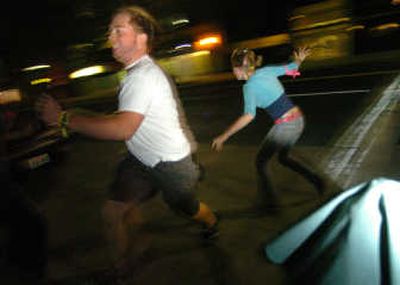Downtown playground

Just after 11 p.m. on a recent Friday, 22-year-old Anthony Moran stepped onto the legs of a Bloomsday statue and read the rules of Urban Capture the Flag to nearly 100 teenagers and young adults.
For those who show up every week to exercise and socialize, it was a routine event. For Moran, it was a privilege to kick off the celebrated game that invades a dozen blocks in the heart of Spokane each Friday night.
“What’s cool about this game, really, is it’s a chance for people of the Spokane community to experience a little freedom,” Moran said after his presentation.
Boys and girls, men and women – from younger than 14 to over 25 – overrun the streets and sidewalks to play the schoolyard game. They break into two teams and conspire to cross into enemy territory and grab the opposing team’s flag.
They can sneak or they can sprint – but if they’re tagged, they go to “jail,” where they remain until a team member can tag them out.
If they manage to run the opposing team’s flag back to their side, their team wins.
But for Travis Rhiel, the self-proclaimed anarchist who started the event last year, it isn’t about winning or losing.
“The idea behind capture the flag is to explore the city in an intimate way and to become familiar with it in a more nontraditional way,” the 23-year-old said.
Rhiel said started publicizing the giant game after hearing about similar events in other cities, including Olympia. Since its inception July 4, 2006, Spokane’s game has attracted new players every week. It’s jumped from about 30 attendees to nearly 100 in a year.
The game spans the sidewalks and courtyards bounded by Spokane Falls Boulevard, Stevens Street, Sprague Avenue and Lincoln Street. Wall Street divides the teams’ territories and is the neutral zone where nobody can get tagged – and where dozens of other youngsters hang out while their peers play.
Kylie “K” Shelton, a 16-year-old student at North Central High School, said she comes every Friday to make friends she wouldn’t have made at school.
A few months ago she met Julius Schott, and the two have been dating since. When he graduated from Lewis and Clark High School in June, the 18-year-old joined the majority of people who turn out for Urban Capture the Flag: college-age kids.
Schott said he likes the diverse crowd – hipsters, students, gay people, jocks and bookworms of all different ethnicities and abilities. And he likes the exercise he gets from running around.
“When you’re really into it, it’s fun,” Schott said. “You don’t really care that you’re getting hurt all the time.”
The threat of injury keeps many people from playing during the icy winter. But there are a few die-hards when things get cold.
“Rain, we’re good. Snow, we’re good,” Shelton said. “But if it’s snowing for about a week, we’ll say, ‘Hey, not this week.’ “
Sometimes during the winter, fewer than 30 people play; on an average summer Friday, 90 isn’t unusual, said 21-year-old Nick Gordon. He’s played with Rhiel and his friends since the beginning – before the downtown game, when they played in city parks and parking lots.
On the recent Friday, Gordon stood on the corner of Wall and Riverside as people strolled and sprinted past. He’s often the “bag man” – manager of the yellow “caution” and red “danger” tape players tie around their heads or wrists to signify their teams.
“We all know each other pretty well – just a bunch of friends having fun,” Gordon said. “I mean, sometimes some troublemakers come out here, but we don’t want that.”
Some players said they’ve had minor run-ins with police. Jaywalking seems to be their biggest crime.
“You can try to follow traffic laws, but when you’re being chased by 30 kids because you’ve got their flag, often it ends up in the street,” Rhiel said.
Officer Jennifer DeRuwe said many patrol officers know about Urban Capture the Flag but aren’t too concerned. If there’s no crime, there’s not much the Spokane Police Department can do, she said. And with few businesses open at 11 p.m., players are unlikely to draw complains.
Rhiel said his anarchist beliefs helped spur him to found Spokane’s game: “It breaks the corporate spell that holds people captive,” he said. Though he knows most young attendees don’t come for the anarchy angle, he said it manifests subconsciously because people start claiming the city as their own.
As for the anarchists who play capture the flag, “some of us look at it as training for altercations with police,” Rhiel said.
Still, the game’s atmosphere has been overwhelmingly innocent.
It’s just kids having fun, said Jason Talbott, a security guard for the Bank of Whitman branch at Wall and Riverside.
He stands watch on Wall Street – the neutral zone – as young people socialize, keeping people from damaging private property. When passers-by see his uniform and his badge, he said, they seem to feel the teenagers are under control.
But mostly he joins in the laughter, shooting quips back at the participants who’ve gotten to know him over the past year.
On one of his Fridays off, he even grabbed some caution tape and joined the game.
“That’s really all I do,” Talbott said. “I keep the peace and watch people make fools of themselves.”
Rhiel, walking quickly back to the neutral zone after his team won the first game that Friday, said the game’s biggest problem can be people who take it too seriously. It’s about fun, not competition, he said.
For 19-year-old John Scott, the game has become a kind of therapy. With troubles at home, socializing with new people made it easier for him to quit smoking pot.
“I started coming to this,” Scott said, “and it just …helped.”